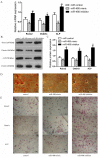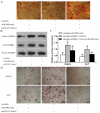miR‑488 negatively regulates osteogenic differentiation of bone marrow mesenchymal stem cells induced by psoralen by targeting Runx2
- PMID: 31485621
- PMCID: PMC6755201
- DOI: 10.3892/mmr.2019.10613
miR‑488 negatively regulates osteogenic differentiation of bone marrow mesenchymal stem cells induced by psoralen by targeting Runx2
Abstract
It has been previously reported that psoralen, one of the active ingredients in Psoralea corylifolia, could induce osteogenic differentiation of bone marrow mesenchymal stem cells (BMSCs), suggesting its potential to treat osteoporosis. Additionally, runt‑related transcription factor 2 (Runx2) is a transcription factor that plays vital roles in BMSC osteogenic differentiation. However, whether and how microRNAs (miRNAs/miRs) modulate osteogenic differentiation induced by psoralen have not yet been examined, to the best of the authors' knowledge. The present study aimed to identify the miRNA target genes that regulate osteogenic differentiation of BMSCs induced by psoralen. A Cell Counting Kit‑8 assay and alizarin red staining were used to detect the viability and osteogenic differentiation of BMSCs, respectively, under treatment with psoralen. miRNA microarray analysis was performed to identify the differentially expressed miRNAs under treatment with psoralen. A bioinformatics analysis and a luciferase reporter assay were conducted to identify the targets of miR‑488. Finally, the mechanisms of miR‑488 in psoralen‑induced BMSC osteogenic differentiation were investigated using overexpression or inhibition methods in vitro. Cell viability was elevated and osteogenic differentiation of BMSCs was improved under treatment with psoralen. miRNA microarray analysis and further validation by reverse transcription‑quantitative PCR revealed that miR‑488 was downregulated during psoralen‑induced BMSC osteogenic differentiation. Bioinformatics analysis and experimental validation by a luciferase reporter assay identified Runx2 as a potential target of miR‑488. Overexpression of miR‑488 by transfection with miR‑488 mimics markedly inhibited the expression of Runx2, Osterix and alkaline phosphatase, whereas, the inhibition of miR‑488 expression by the miR‑488 inhibitor promoted their expression compared with the control. Rescue assays demonstrated that Runx2 overexpression partially rescued the inhibitory effect of miR‑488 on BMSC osteogenic differentiation. The present results suggested that miR‑488 is a negative regulator of psoralen‑induced BMSC osteogenic differentiation by targeting Runx2, providing a possible therapeutic target for osteoporosis.
Figures





Similar articles
-
Involvement of microRNA-23b in TNF-α-reduced BMSC osteogenic differentiation via targeting runx2.J Bone Miner Metab. 2018 Nov;36(6):648-660. doi: 10.1007/s00774-017-0886-8. Epub 2017 Dec 12. J Bone Miner Metab. 2018. PMID: 29234953
-
Decrease of MiR-31 induced by TNF-α inhibitor activates SATB2/RUNX2 pathway and promotes osteogenic differentiation in ethanol-induced osteonecrosis.J Cell Physiol. 2019 Apr;234(4):4314-4326. doi: 10.1002/jcp.27210. Epub 2018 Aug 21. J Cell Physiol. 2019. PMID: 30132874
-
MiRNA-365a-3p promotes the progression of osteoporosis by inhibiting osteogenic differentiation via targeting RUNX2.Eur Rev Med Pharmacol Sci. 2019 Sep;23(18):7766-7774. doi: 10.26355/eurrev_201909_18986. Eur Rev Med Pharmacol Sci. 2019. PMID: 31599402
-
Roles for miRNAs in osteogenic differentiation of bone marrow mesenchymal stem cells.Stem Cell Res Ther. 2019 Jun 28;10(1):197. doi: 10.1186/s13287-019-1309-7. Stem Cell Res Ther. 2019. PMID: 31253175 Free PMC article. Review.
-
[The Study of Signal Pathway Regulating the Osteogenic Differentiation of Bone Marrow Mesenchymal Stem Cells].Sichuan Da Xue Xue Bao Yi Xue Ban. 2020 Nov;51(6):777-782. doi: 10.12182/20201160103. Sichuan Da Xue Xue Bao Yi Xue Ban. 2020. PMID: 33236600 Review. Chinese.
Cited by
-
Psoralen alleviates high glucose-induced HK-2 cell injury by inhibition of Smad 2 signaling via upregulation of microRNA 874.BMC Pharmacol Toxicol. 2020 Jul 22;21(1):52. doi: 10.1186/s40360-020-00434-1. BMC Pharmacol Toxicol. 2020. PMID: 32698907 Free PMC article.
-
Carbon Monoxide-Releasing Molecule-3 Enhances Osteogenic Differentiation of Rat Bone Marrow Mesenchymal Stem Cells via miR-195-5p/Wnt3a Pathway.Drug Des Devel Ther. 2022 Jul 2;16:2101-2117. doi: 10.2147/DDDT.S367277. eCollection 2022. Drug Des Devel Ther. 2022. PMID: 35812136 Free PMC article.
-
Effects of 0.01 mM strontium on human periodontal ligament stem cell osteogenic differentiation via the Wnt/β-catenin signaling pathway.J Int Med Res. 2025 Feb;53(2):3000605251315024. doi: 10.1177/03000605251315024. J Int Med Res. 2025. PMID: 39932304 Free PMC article.
-
A Review of the Pharmacological Properties of Psoralen.Front Pharmacol. 2020 Sep 4;11:571535. doi: 10.3389/fphar.2020.571535. eCollection 2020. Front Pharmacol. 2020. PMID: 33013413 Free PMC article. Review.
-
Berberine ameliorates the LPS-induced imbalance of osteogenic and adipogenic differentiation in rat bone marrow-derived mesenchymal stem cells.Mol Med Rep. 2021 May;23(5):350. doi: 10.3892/mmr.2021.11989. Epub 2021 Mar 24. Mol Med Rep. 2021. PMID: 33760123 Free PMC article.

